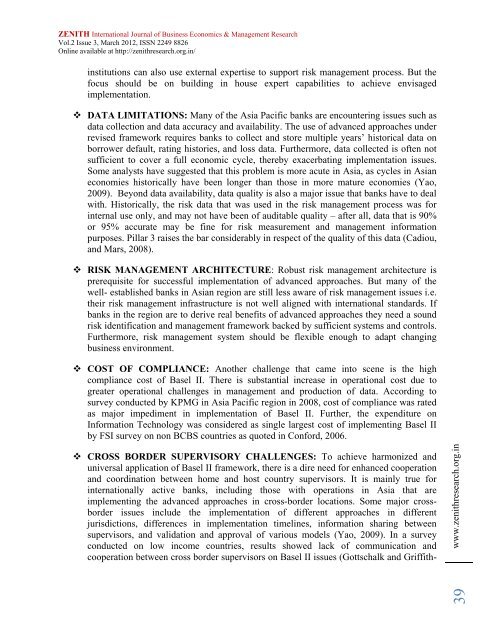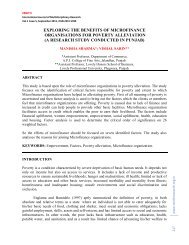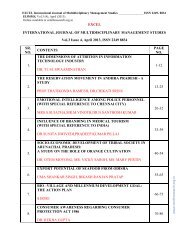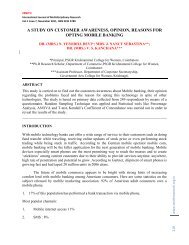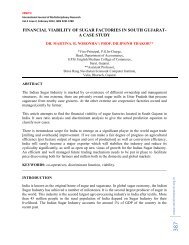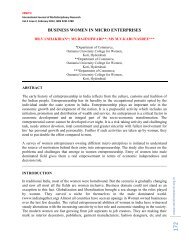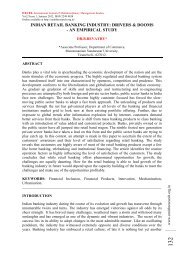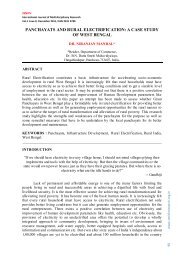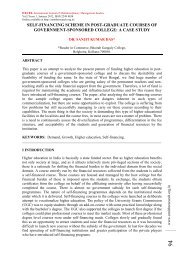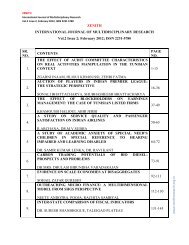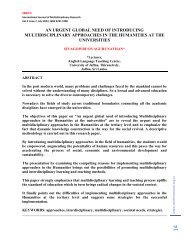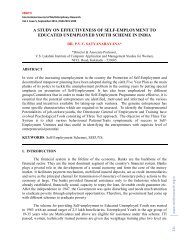ZIJBEMR MARCH 2012 ISSUE COMPLETE.pdf - zenith ...
ZIJBEMR MARCH 2012 ISSUE COMPLETE.pdf - zenith ...
ZIJBEMR MARCH 2012 ISSUE COMPLETE.pdf - zenith ...
You also want an ePaper? Increase the reach of your titles
YUMPU automatically turns print PDFs into web optimized ePapers that Google loves.
39www.<strong>zenith</strong>research.org.inZENITH International Journal of Business Economics & Management ResearchVol.2 Issue 3, March <strong>2012</strong>, ISSN 2249 8826Online available at http://<strong>zenith</strong>research.org.in/institutions can also use external expertise to support risk management process. But thefocus should be on building in house expert capabilities to achieve envisagedimplementation. DATA LIMITATIONS: Many of the Asia Pacific banks are encountering issues such asdata collection and data accuracy and availability. The use of advanced approaches underrevised framework requires banks to collect and store multiple years’ historical data onborrower default, rating histories, and loss data. Furthermore, data collected is often notsufficient to cover a full economic cycle, thereby exacerbating implementation issues.Some analysts have suggested that this problem is more acute in Asia, as cycles in Asianeconomies historically have been longer than those in more mature economies (Yao,2009). Beyond data availability, data quality is also a major issue that banks have to dealwith. Historically, the risk data that was used in the risk management process was forinternal use only, and may not have been of auditable quality – after all, data that is 90%or 95% accurate may be fine for risk measurement and management informationpurposes. Pillar 3 raises the bar considerably in respect of the quality of this data (Cadiou,and Mars, 2008). RISK MANAGEMENT ARCHITECTURE: Robust risk management architecture isprerequisite for successful implementation of advanced approaches. But many of thewell- established banks in Asian region are still less aware of risk management issues i.e.their risk management infrastructure is not well aligned with international standards. Ifbanks in the region are to derive real benefits of advanced approaches they need a soundrisk identification and management framework backed by sufficient systems and controls.Furthermore, risk management system should be flexible enough to adapt changingbusiness environment. COST OF COMPLIANCE: Another challenge that came into scene is the highcompliance cost of Basel II. There is substantial increase in operational cost due togreater operational challenges in management and production of data. According tosurvey conducted by KPMG in Asia Pacific region in 2008, cost of compliance was ratedas major impediment in implementation of Basel II. Further, the expenditure onInformation Technology was considered as single largest cost of implementing Basel IIby FSI survey on non BCBS countries as quoted in Conford, 2006. CROSS BORDER SUPERVISORY CHALLENGES: To achieve harmonized anduniversal application of Basel II framework, there is a dire need for enhanced cooperationand coordination between home and host country supervisors. It is mainly true forinternationally active banks, including those with operations in Asia that areimplementing the advanced approaches in cross-border locations. Some major crossborderissues include the implementation of different approaches in differentjurisdictions, differences in implementation timelines, information sharing betweensupervisors, and validation and approval of various models (Yao, 2009). In a surveyconducted on low income countries, results showed lack of communication andcooperation between cross border supervisors on Basel II issues (Gottschalk and Griffith-


